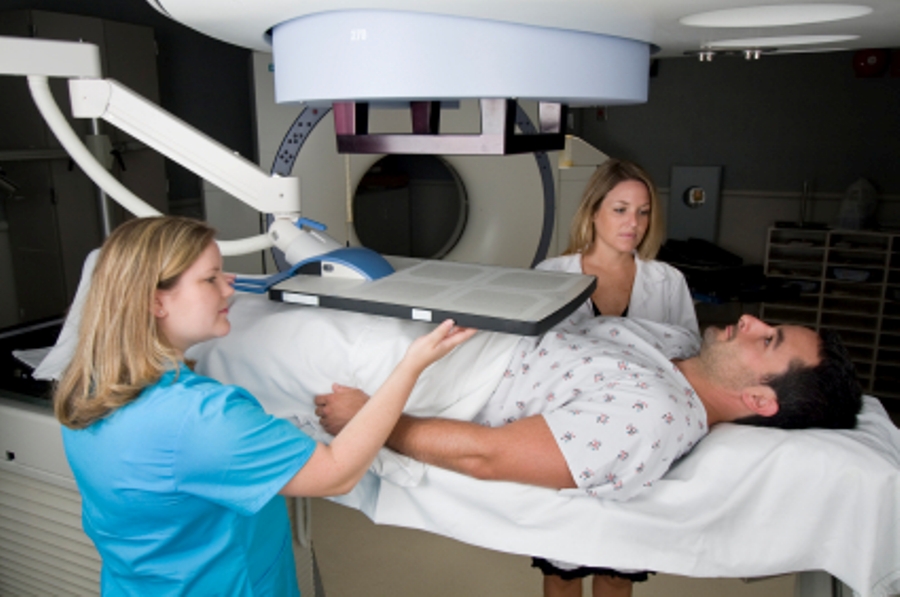
Grading and Staging of Prostate Cancer
Doctors often use two classification systems, called the TMN classification system or the Gleason system to characterize the tumor type.
TMN classification
To classify a tumor, doctors most often use a method called the TMN system, which is based on the tumor size (T), whether it has spread to lymph nodes (N), and if it has metastasized (traveled) to distant regions or organs of the body (M). Doctors additionally assign each letter (T, N, and M) a number, which measures how much the cancer has advanced. Larger numbers correspond to more advanced cancers. Doctors then use the TMN system to group multiple tumor types into a single staging group which allows them to provide appropriate treatment based on the severity of the cancer.
T1 cancer is not large enough to be felt by a doctor, but it can be seen with certain visualization procedures.
T2 cancer is large enough to felt by the doctor performing a rectal exam, but upon examination, the tumor remains confined to the prostate.
T3 cancer is large and has spread outside of the prostate.
T4 cancer has spread to distant tissues far away from the prostate.
N classifications
N0: The cancer has not spread to the lymph nodes.
N1: The cancer has spread to one or more lymph nodes.
M classifications
M0: The cancer has not spread to any tissue including lymph nodes.
M1: The cancer has spread to distant lymph nodes, bone, or other tissues.
Stage Grouping
Stage I: Includes tumors that can always be visualized by at least one detection or visualization procedure and may or may no be felt via a rectal exam. This cancer remains confined to the prostate. It includes tumors classified in the TMN system as:
- T1, N0, M0
- T2, N0, M0
Stage II: Includes tumors that may or may not be felt via a rectal exam, but like stage I, the stage II tumors can always be visualized by at least one detection or visualization procedure. In this stage, the cancer remains confined to the prostate and has not spread to nearby lymph nodes or distant tissues. However, stage II differs from stage I because there is more abnormal cancerous tissue. It includes tumors classified in the TMN system as:
- T1, N0, M0
- T2, N0, M0
Stage III: Includes tumors that are usually felt by a rectal exam, though feeling the tumor is not a requirement for stage III. This tumor type has not spread to nearby lymph nodes or elsewhere in the body. However, the cancerous tissue appears even more abnormal that stage I or II. It includes tumors classified in the TMN system as:
- T3, N0, M0
Stage IV: Includes tumors that have spread to nearby lymph nodes or tissues. It includes tumors classified in the TMN system as:
- T4, N0, M0
- T1-4, N1, M0
- T1-4, N1-4, M1
Gleason Classification
When a doctor suspects prostate cancer, a biopsy will be performed. A biopsy requires taking a sample of the suspicious tumor or mass and examining for the presence of cancer cells. The tissues sampled with be labeled with a grade based on the tumor characteristics. This grade is based upon the Gleason system, which allows for tumors to be classified from a number of 1-5.
Grade 1: The tumor resembles normal prostate tissue.
Grade 2-4: The tumor contains more abnormal looking tissue.
Grade 5: The tumor contains extremely abnormal tissue.
Often, the tumor contains multiple areas that each are labeled with different grades. Therefore, doctors assign a grade to 2 different areas on the tumor. A doctor then produces a Gleason score (also called Gleason sum) by adding the grade number from the two different areas together. This provides a value between 2 and 10 that describes the severity of the tumor.
A Gleason score of 6 or less is also called a low-grade tumor
A Gleason score of 7 is also called an intermediate-grade tumor
A Gleason score of 8-10 is also called a high-grade tumor.
Although a prostate tumor can fall within any of these grades or Gleason scores, most prostate cancers are classified as grade 3 or higher, and given a Gleason score of at least 6.
Non-Cancerous Classifications
Occasionally a doctor may observe suspicious tissue that does not have the same characteristics of prostate cancer. In these cases, doctors assign the suspicious tissue one of three classifications.
Prostatic intraepithelial neoplasia (PIN): when the suspicious tissue appears abnormal, but also not appear cancerous. Often this classification is applied if the suspicious tissue has not expanded into other prostate areas. PIN tissue is also further classified as low-grade PIN if the tissue has an appearance closer to normal tissue, or high-grade PIN if the tissue has an appearance closer to cancerous tissue. A diagnosis of low-grade PIN is considered low risk for developing into prostate cancer. A diagnosis of high-grade PIN however, provides the patient with a 20% chance that cancer is present in a different portion of the prostate than that which was examined. Therefore, doctors typically repeat the biopsy in men with a high grade PIN diagnosis.
Atypical small acinar proliferation (ASAP): Doctors diagnosis ASAP when the tissue sample contains a few cancer cells, but not enough for a diagnosis. Often, doctors will repeat the biopsy in men with ASAP because it is likely that cancer is present elsewhere in the prostate.
Proliferative inflammatory atrophy (PIA): Doctors diagnosis PIA when there is a large amount of inflammation in the prostate. Although PIA is not cancer, PIA often leads to high-grade PIN or prostate cancer. Therefore, doctors typically monitor patients with a PIA diagnosis very closely to detect the development of cancer.




